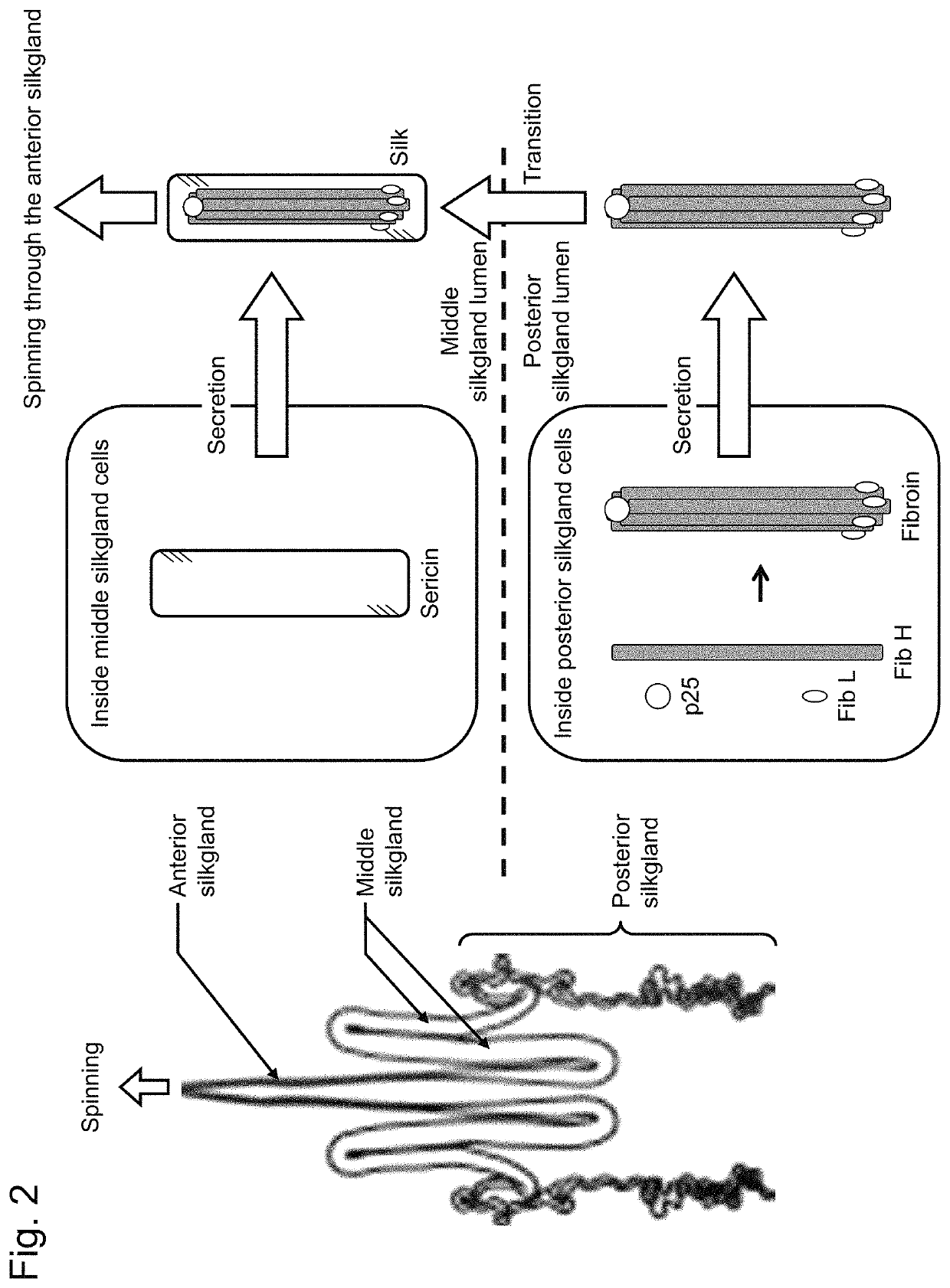Recombinant bagworm silk
a bagworm silk and transgenic technology, applied in the field of bagworm silk and transgenic silkworm, can solve the problems of mass production, insufficient number of bagworm nests that can be collected in the field, and practicable use of bagworm silk
- Summary
- Abstract
- Description
- Claims
- Application Information
AI Technical Summary
Benefits of technology
Problems solved by technology
Method used
Image
Examples
example 1
Cloning of the Bagworm Fib H Gene
(Object)
[0125]The object is to clone an unknown bagworm Fib H gene.
(Method)
[0126]Larvae of Eumeta japonica collected outdoors in Abiko, Chiba, Japan were dissected to isolate silkglands. The isolated silkglands were homogenized in RNA extraction reagent, ISOGEN (Nippon Gene Co. Ltd.) and total RNA was extracted using SV Total RNA Isolation system (Promega Corporation). The extracted total RNA was used as a template to produce a cDNA library using TruSeq RNA Sample Preparation Kit v2 (Illumina Inc.). The resulting cDNA library was subjected to RNAseq analysis using a next-generation sequencer Hiseq 2500. The obtained 101bp×2 paired-end read sequence data was used for de novo assembly analysis using blast search and trinity.
(Results)
[0127]The de novo assembly analysis successfully identified an about 750-bp base sequence shown in SEQ ID NO: 24 encoding the N-terminal region of the Eumeta japonica Fib H, an about 1020-bp base sequence shown in SEQ ID NO...
example 2
Construction of an Expression Vector of a Modified Bagworm Fib H
(Object)
[0128]The object is to construct an expression vector of a full-length chimeric Fib H gene on the basis of the information of the partial sequences of the bagworm Fib H gene from Eumeta japonica obtained in Example 1 and the information of the silkworm Fib H gene.
(Method and Results)
[0129]The information of the base sequences obtained in Example 1 corresponded to partial regions in the bagworm Fib H gene from Eumeta japonica (N-terminal, central, and C-terminal regions). The transcription product of the Eumeta japonica Fib H gene is predicted to have a total length of about 10 kbp. Thus, to make a recombinant construct in a form that can be used from the bagworm Fib H gene, a modified bagworm Fib H gene consisting of a chimeric gene between the bagworm and silkworm was constructed by the following procedures, based on the information of the base sequences of the fragments of Eumeta japonica Fib H gene obtained i...
example 3
Establishment of Transgenic Silkworms
(Object)
[0132]The object is to produce a transgenic silkworm introduced with the expression vector established in Example 2.
(Method and Results)
[0133]The expression vector of a modified bagworm Fib H gene (pBac3xP3eGFP-BmEv01HFB-F31 / R31) established in Example 2 was injected into 288 eggs of the silkworm wlpnd strain according to a conventional method (Tamura T. et al., 2000, Nat Biotechnol, 18: 81-84), and the resulting adult insects were sib-mated (G0 mating) to produce 38 moth groups. Among these groups, recombinants of 92 individuals (G1 eggs) from eight moth groups were subjected to screening. Fifty-six individuals hatched from G1 eggs, and 34 individual adult insects of the modified bagworm Fib H gene transgenic silkworms were obtained.
[0134]Production of modified bagworm Fib H gene transgenic silkworms was performed again by a similar method. pBac3xP3eGFP-BmEv01HFB-F31 / R31 was injected into 384 eggs of the silkworm wlpnd strain according t...
PUM
| Property | Measurement | Unit |
|---|---|---|
| temperature | aaaaa | aaaaa |
| temperature | aaaaa | aaaaa |
| speed | aaaaa | aaaaa |
Abstract
Description
Claims
Application Information
 Login to View More
Login to View More - R&D
- Intellectual Property
- Life Sciences
- Materials
- Tech Scout
- Unparalleled Data Quality
- Higher Quality Content
- 60% Fewer Hallucinations
Browse by: Latest US Patents, China's latest patents, Technical Efficacy Thesaurus, Application Domain, Technology Topic, Popular Technical Reports.
© 2025 PatSnap. All rights reserved.Legal|Privacy policy|Modern Slavery Act Transparency Statement|Sitemap|About US| Contact US: help@patsnap.com


